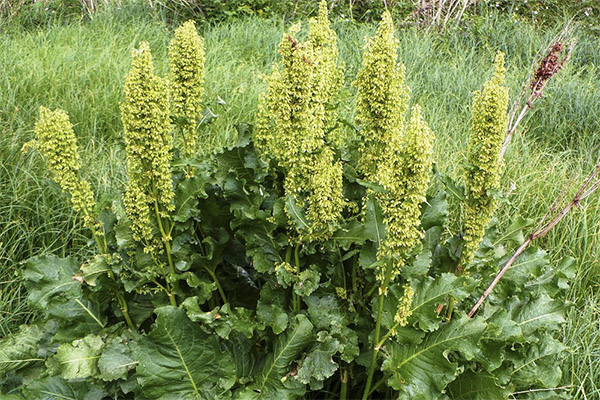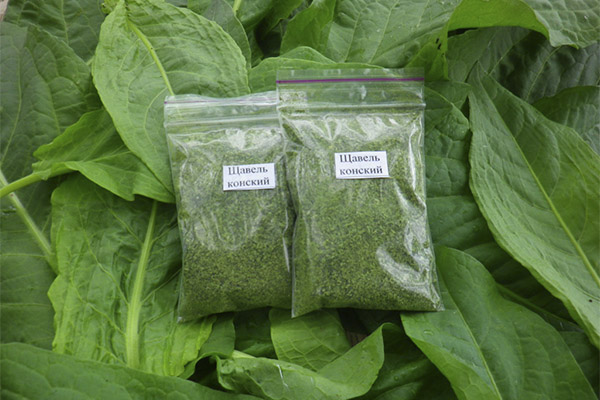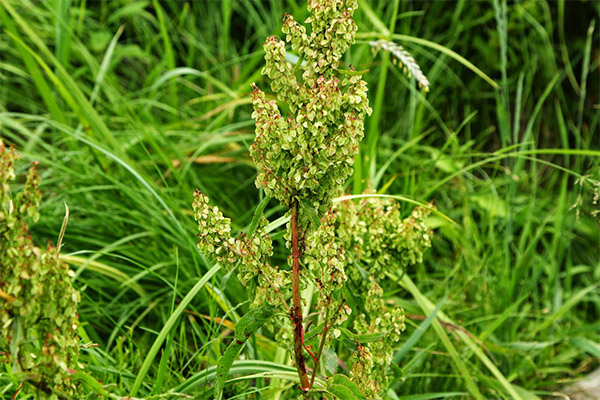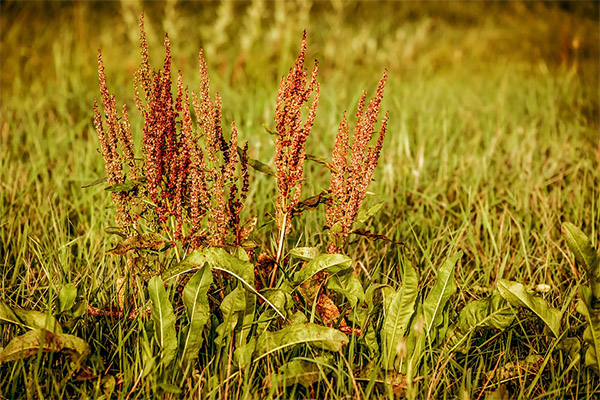Horse sorrel: therapeutic properties and contraindications
People have thought up numerous names for horse sorrel! It is referred to as horse or frog sourdough, and hernia ognevka, and horse sorrel, and aveluk, and Armenian grass, and horsemeat. There are many nicknames, some even with a slight disparaging connotation, but meanwhile this plant is a close relative of buckwheat, the porridge of which is loved by everyone, with perhaps a few exceptions. And in itself, horse sorrel is worthy of attention and respect, because it contains many useful substances for humans.
- Chemical composition
- How it looks and where it grows
- Horseradish Harvest and Storage
- How to distinguish horseradish from horse sorrel
- Therapeutic properties of horse sorrel
- Horse sorrel in folk medicine
- Sorrel juice for skin cancer
- Calming remedy
- From hangover
- From cystitis
- For slimming
- Types of medicinal compositions with horse sorrel
- Infusion
- Tincture
- Decoction
- Tea
- Cosmetic Applications
- For blackheads
- For Dry Skin
- For oily skin
- Whitening mask
- Cleansing Mask
- Ice cubes with sorrel
- Brandy Lotion
- Infusion for Hair
- Can I eat horse sorrel?
- Three Minute Salad
- Vitamin Salad
- Salmon and horse sorrel
- Dish with horse sorrel
- Fried patties
- Sorrel kissel
- Mushrooms with horse sorrel
- Can we give rabbits horse sorrel
- Contraindications to use
Chemical Composition
Horse sorrel is not only a well-known plant, but also a well-studied one. Scientists, medics, cosmetologists and folk healers know about its rich chemical composition. First of all, experts say that sorrel is a treasure trove of various useful substances. These are organic acids - oxalic, caffeic, lactic, citric and chrysophanic with all its derivatives.

The plant generously shares vitamins C, K, P, flavonoids, pectins, iron, essential oils, coumarins. Besides 15-16% of the weight of dried plant material are tannins (or tannins), the use of plant material in leather production is based on their action, and thanks to the presence of carotene (vegetable pigment) it is used in the manufacture of dyes for fabrics in black and yellow colors. To complete the picture of the components of sorrel the presence of various trace elements (magnesium, sodium, phosphorus, manganese, fluorine, calcium, copper).
What it looks like and where it grows
This tall plant is visible from afar and difficult to confuse with any other plant. Its sturdy stems, up to a meter and a half high, branch out to form an entire bush and can reach a thickness of 2 cm. Its leaves are elongated, but of two types. One forms a root rosette, sits on long petioles and has a rounded top. They can be up to 25 cm long and about 12 cm wide. Other leaves are located throughout the smooth stem, their petioles are shorter and slightly reddish where they are attached to the stem. The leaves themselves are smaller than the root ones, narrower and more pointed, and covered on the underside with short, stiff hairs.
Flowering begins in late May and lasts through June, the flowers are small, green-yellow in appearance similar to immature buckwheat. They are gathered in a small, tall, dense inflorescence and turn brown as they mature. They bear small fruits-nuts that can survive the fall without falling off and hang on the stems for most of the winter.
On the whole, the plant is large, powerful, and succulent. Surprisingly, the rhizome of such a giant is not particularly large. It is short and not strongly branched, but it is thick and has many adventitious roots.
In the European part of the former USSR it is found everywhere, except perhaps in the Far North, not only in Russia, but also in neighboring countries. It grows both in forests and in steppes, preferring to settle down wherever there is abundance of life-giving moisture. It prefers both the banks of wide rivers and the neighborhoods of quiet ponds. It does not mind spring floods, but cannot bear boggy soils.
Forest edges and glades, roadsides and vegetable gardens, fields and ravines - horse sorrel feels at ease everywhere. But still its favorite element is meadows. It can exist both as a solitary plant, decorating the surroundings with its single person, and as a small group of several pieces, as well as occupying entire vast areas - up to several hectares, not giving a chance for other grasses and even bushes to live. But if such an area is systematically mowed or cattle are allowed on it, the sorrel may not resume growth on it the next year and simply degenerate.
Harvesting and storing
To pick horse sorrel, it is necessary to go far away from civilization - to fields, woods, meadows, to the shores of natural bodies of water. This is where the most healthy and safest plants grow, while near roads, in populated areas or near them there is a high probability that you will pick sorrel, which has absorbed dangerous substances released by automobile exhaust or industrial emissions. You should choose warm, nice weather, without rain, for picking.
All parts of horse sorrel can be harvested. Leaves and stems are best collected in early summer, in June, when the plant is just beginning to bloom, and young tender leaves are even edible because they are not yet bitter. The collected herbs are washed under cold running water and dried as a whole. It is important to dry them in a shaded and well-ventilated place, not in the sun.
A little later - in July - the harvesting of seeds begins. They have already acquired a red color by that time. Seeds should be carefully sorted out, select all the trash and put in glass jars for storage.
To collect the root, both autumn and spring are suitable - at a time when the green part of the plant either has not yet appeared, or is already dying off. More convenient, of course, in the fall, when the above-ground part of the sorrel is still standing, and there is no danger of digging out some other, unknown, but very similar rhizome instead of the desired one.
The rhizome is well cleaned of dirt, washed with running water and placed in a sunny area so that it will dry out. Shred by cutting the thick roots in half lengthwise, and then dry all the way out on the veranda under a canopy. If the weather is damp and the air is humid, it is possible to finish drying in the oven at a low flame and with the door ajar. You can store like leaves in glass containers, wicker baskets with a lid, or cardboard boxes.
The above-ground part will last a year without loss of quality, the root can be stored longer - up to three years.
If you decide not to dry sorrel, but to freeze it (this option is also possible), it should be chopped before putting it into the freezer. Thawed product cannot be sliced. And do not be frightened by the consistency of thawed sorrel, the useful substances in it are still preserved.
How to distinguish horseradish from horse sorrel
To confuse horseradish with horse sorrel an inexperienced person can, although they are different. Horseradish grows out of the ground in a huge rosette and on fertile soil can reach a length of 80-100 cm. The color of young horseradish leaves is light green, later they become darker and richer in color. They are quite wide, rounded at the top, and look slightly wrinkled, as if unironed laundry. When you bite into a leaf, you can feel a slight burning sensation, which horseradish does not have.
Horseradish blooms are rare and not every dacha owner. Some people cultivate this plant for years and have no idea that it can bloom. Its flowers are small, white in color, gathered in loose, loose tassels - against the dense, narrow tassel of green of the sorrel. Horseradish also has a few small leaves on its flowering stem.
The timing of horseradish and horse sorrel flowering is different: while the former enters this life stage in late May or early June, horseradish does it a month later, when the sorrel has already flowered and the seeds are fully ripe. The roots of the two plants are also different: horseradish is almost white, while sorrel is much darker, almost chocolate-colored.
The medicinal properties of horse sorrel
Since the time of the Persian physician Avicenna, horse sorrel has been known for its ability to help the sick. It is recognized by both official medicine and folk medicine. Herbal gatherings or remedies that include this herb are sold at any pharmacy. First of all, doctors prescribe them for pulmonological problems and in dermatology. So, pills treat sinusitis, and solutions remove simple and plantar warts, acute condyloma, as well as fight with seborrheic keratosis.

Medicine has long learned to use absolutely every part of the sorrel, but still the most effective is considered the use of the root - because of the maximum concentration of useful substances.
- Potions of horse sorrel lend themselves to diseases of the digestive system, liver, skin, respiratory organs, in particular bronchitis.
- With atherosclerosis, sorrel reduces cholesterol, fights with deposits in blood vessels, dissolving atherosclerotic plaques. It has the ability to alleviate the condition of hypertensive people, relieves headaches.
- The astringent effect of sorrel, obtained through its constituent tannins, is widely used in the treatment of diarrhea, colitis and enterocolitis. The plant is also used as a choleretic.
- It is also known hemostatic effect of sorrel, so it is appointed for intestinal, pulmonary, stomach and uterine bleeding, as well as hemorrhoids.
- It also finds use as a bactericidal and immunostimulating agent, it is used by dentists, dermatologists, gynecologists. Eczema, scabies, wounds, boils - horse sorrel successfully copes with all these problems, treats and sore throat with angina. As a bactericidal agent, sorrel is safely used in dysentery.
- Herbalists have long prescribed it to weakened and emaciated patients to increase appetite.
Horse sorrel in folk medicine
Among herbalists, healers and shamans, horse sorrel has always been popular for its useful properties and the wide availability of medicinal raw materials. It was recommended as a prophylactic remedy for vitamin deficiency and gum disease, offering to chew a young leaf of the plant. Juice from freshly picked leaves treated migraine, rubbed it on the temples and even used as an anthelmintic. A paste of sour cream mixed with finely chopped sorrel was used to smear problem skin. The juice of the plant was even recommended for complex pathologies, such as the early stages of stomach cancer and external manifestations of skin cancer.
Modern folk medicine does not abandon the traditions of the ancient witches and continues to make wide use of sorrel for these diseases - though it is necessarily combined with the treatment prescribed by doctors.
Sorrel juice for skin cancer
Getting sorrel juice is not difficult with the help of an ordinary juicer. Take it every hour, diluting 3-5 drops in water. Cancer formations on the skin are rubbed with undiluted juice. Herbalists recommend adding 3-5 drops of juice to yarrow tea for those who suffer from Parkinson's disease.
Soothing remedy
Horse sorrel has a mild sedative effect. With the help of the infusion you can get rid of pain in the lower abdomen during menstruation, because it relieves spasms. This remedy will also help with menopause, putting the nervous system in order and improving sleep. The recipe is simple: pour a tablespoon of sorrel with a glass of boiling water, soak for an hour and divide the composition into three parts, drink in a day - in the morning, at lunch and in the evening.
From hangover syndrome
The ability to reduce hangover syndrome is based on the high content of vitamin C in horse sorrel. Just a glass of infusion is enough: a teaspoon of green leaves pour 500 ml of boiling water. You can drink after a quarter of an hour. If necessary, you can repeat the procedure in two or three hours.
For cystitis
This problem is very well known to women. Sorrel successfully copes with its solution thanks to its disinfectant and diuretic properties. Pour 500 ml of boiling water a tablespoon of leaves, insist a few minutes, drink three times a day.
For weight loss
The ability of horse sorrel to improve the digestive system is suitable for those who are trying to lose excess weight. Use this recipe in a comprehensive weight loss program. Grind an apple and a banana in a blender, pour 2 cups of boiled water and a handful of finely chopped sorrel. Mix it to get a smoothie. Pour into a glass, garnish with a mint leaf and you can drink.
Horse sorrel concoctions

Infusion
- With diarrhea. Pour a glass of boiling water over 15 grams of crushed dried roots and the same amount of seeds, steamed for 5 minutes in a water bath at a medium boil, pour into a thermos, where insist at least two hours. It will help with diarrhea, as well as an aid in the treatment of liver problems.
- In case of sore throat. Gargle with an infusion: 20 grams of dried sorrel (never mind - the root or herbs) pour a glass of steep boiling water and insist 15 minutes. Use when the infusion cools.
- When itching of the skin. To relieve skin itching will help infusion of 20 grams of freshly harvested leaves. Pour them in a glass of water and boil for 10 minutes over low heat. Cover well and allow to stand for an hour. Use both externally, rubbing the itchy places, and internally - drink a teaspoon in the morning, afternoon and evening.
Tincture .
To relieve pain of a rheumatic nature, prepare an alcoholic tincture. For this you will need sorrel seeds and crushed root. At one part take 10 parts of vodka, pour it over dry raw material and insist in a dark place for half a month. After straining, use half an hour before a meal. In a tablespoon add 15-25 drops of tincture and pour a spoonful of boiled water. Drink three times a day.
Decoction .
Generally, decoctions of sorrel are recommended by folk healers as a means to normalize digestion. After preparation, they can be stored in the refrigerator, but only for 2 days, no longer.
- In hemorrhoids. Such a decoction should be drunk before meals 4 times a day for a quarter of a cup. To do this, pour 2 teaspoons of dried sorrel in a mug with 200 ml of water and leave for 2 hours to soften. Then keep the mug on low heat for about 5 minutes and let cool. Drink strained.
- For diseases of the mouth. If the gums are inflamed, tormented by periodontal disease or stomatitis, the mouth should be rinsed with a decoction prepared according to the following recipe. Grind sorrel root, put a tablespoon mixture in an enamel ladle, pour into it a glass (250 ml) of steep boiling water, leave until it cools. Then put on the fire and boil for 5 minutes. Strain and use in warm form.
- When diathesis in a child. You can prepare a decoction for bathing. Grind 150 grams of dried sorrel root and pour into 500 ml of cold water, let stand for half an hour, and then boil for about 15 minutes over low heat, allow to cool and simultaneously infuse. Strain and pour into the bath. The same method is effective for hemorrhoids.
- For digestive problems. A tablespoon of crushed dried root poured into a glass of boiled water, leave for an hour. Then boil in a water bath for 40 minutes and leave until it cools. After straining, you can use, pre-diluted with water.
- With atherosclerosis. A tablespoon of dry milled material pour a glass of boiling water, boil over low heat for 15 minutes, remove from the heat and wrap for 2 hours. Drink 2 tablespoons in the morning and evening. Use as an aid in atherosclerosis. With signs of impaired cerebral circulation, it is necessary to increase the rate of intake twice and drink the decoction three times a day.
Tea
Sorrel tea is recommended in cases where heartburn is tormented, a slight discomfort is felt in the liver area or there are minor malfunctions in the digestive system. Brew as usual tea at the rate of a teaspoon of dried raw sorrel in a small glass of steeped boiling water (about 200 ml.). Infuse, cool and only then drink.
Cosmetic applications
Sorrel masks are suitable for any woman - regardless of age and skin type. The active substances of the plant will help with inflammation on the face, work on the lightening of age spots and freckles, straighten wrinkles, tidy pores on the skin, get rid of greasy gloss, save from acne and pimples. Sorrel can solve such a wide range of cosmetic problems thanks to its constituent components, which have a complex effect on the skin.

Ascorbic acid (vitamin C) is responsible for normal oiliness, thiamine (vitamin B1) and organic acids help to preserve youthfulness longer and have a tightening effect, and flavonoids, by stimulating the formation of collagen, allow the skin to be elastic and firm. Phylloquinone (vitamin K) and niacin (vitamin PP) make the face fresh and bright.
Mask at home is not difficult to prepare, you can use all parts of the plants - from root to inflorescence. Sorrel is washed, steeped and then finely chopped with a knife. Now you can crush it with your hands until the juice separates.
Before applying the oxalic mask to the face, you should conduct a sensitivity test to make sure that the acids contained in oxalic sorrel will not harm the skin. On the wrist or the bend of the elbow from the inside put a little bit of the mass prepared for the mask, and wait a while. If the skin in this place begins to itch, burn and redden, the idea of making a mask will have to be abandoned.
To reduce the negative effects of sorrel on the skin, you need to add additional components to the mask and not to keep the product longer than 10 minutes. Wash off with soothing herbal decoction, and then apply moisturizing cream to your face.
Oily skin can be pampered with oxalic mask every other day, normal skin - no more than twice a week, and dry skin - no more than once in 10 days. It is best to spend such a vitamin course for a month, and then give your skin a rest for the same amount of time.
Never try to use any mask or lotion made of sorrel if your skin is highly sensitive or if there is any irritation on it at the moment.
For blackheads
Cut a tablespoon of leaves of sorrel, add to the composition the same amount of dried flowers of calendula or chamomile and pour into 250 ml of boiling water. Boil for another 5 minutes and cool. Use gauze or a fine strainer to separate the broth and dilute it with mineral water. Mineral water should be the same amount as the broth. Apply the resulting porridge to the face for 10 minutes. Wash off with decoction and mineral water.
For dry skin
Mix a tablespoonful and a teaspoonful of fat sour cream and a teaspoonful of sunflower oil with two tablespoons of finely chopped young sorrel leaves. The resulting composition generously put on your face, and after 20 minutes, wash with warm water.
For oily skin
Chop the leaves of the sorrel to get 50 g of green mass. Add the protein of a chicken egg and 10 ml of lemon juice. Stir gently and put the mixture on your face for 10-15 minutes. Soak a cotton pad with green tea and remove the healing remedy with it. This mask will not only refresh, but also tighten the pores on the skin.
Whitening mask
Put chopped sorrel leaves, spinach and parsley in a bowl, taking the herbs in equal proportions - about half a tablespoon each. Then add to this green mass a little kefir, two spoons will suffice. Then mix it and spread it on your face (to prevent the mass from dripping, you'll have to lie down a little). Keep for a quarter of an hour, remove the rest with cold water.
Purifying mask
Take a tablespoon each of three ingredients: chopped leaves of sorrel, yarrow and flakes "Hercules". Combine, pour boiled water to the point of sour cream, stir well once more and put on your face. Leave on for 15 minutes, rinse with cool water.
Ice cubes with sorrel
Pour a glass of boiling water with a mixture of 2 tablespoons of chopped sorrel leaves, a tablespoon of mother and stepmother. Close tightly with a lid, that all is well steamed. Insist at least 3 hours. Then strain and pour the broth into molds for ice cubes. Take in the freezer, to use later for rubbing the face in the morning and evening.
The rest of the decoction herbal mush can be applied to the face, after 15 minutes rinse with cool boiled water.
Cognac lotion
Pour 100 grams of brandy over a mixture of crushed sorrel leaf, calendula and chamomile flowers (take 5 pieces each) and 4 plantain leaves. Take for 10 days in the refrigerator, then strain. Put in refrigerator and every day after waking up and before going to bed, wipe your face with it.
Infusion for hair
Root of horse sorrel in the form of infusion is good to rinse hair if itchy scalp. To prepare it, boil 45 grams of crushed root in two liters of water for 10-15 minutes, then infuse about an hour - and you can rinse your hair after washing. If you regularly use this remedy, the hair follicles will be restored, the hair will become healthy and shiny, it will gain volume.
Can I eat horse sorrel?
Both leaves and petioles of horse sorrel can be used as food. Its leaves are used for cooking salads, stuffing for pies, various soups and other culinary masterpieces. Horse sorrel is delicious in the same dish with cucumbers or tomatoes. Radish, young garlic and green onions are good companions for it. But only young, small leaves, which are not so bitter, should be used. In the Caucasus (mainly in Armenia), they braid the leaves and dry them in the fresh air. As a result, they ferment and darken like tea, the bitterness disappears and a spicy taste appears. Such pigtails are called aveluk. You can buy them at markets, this dish is on the menus of restaurants and cafes. Aveluk is served with brynza and cheeses, it goes well with flatbread or pita bread, with the addition of matsun sauce. It is also used in soups and sauces.

Salad "Three minutes".
It is so called because it takes exactly that long to prepare - 3 minutes, no longer. Wash 2-3 young leaves of horse sorrel under running water, shake off the water, chop the leaves finely enough. Also chop 2 hard-boiled eggs. Mix the greens and eggs, salt, pepper, add a little sugar. Sour cream is used as dressing in this salad.
Salad "Vitamin".
To prepare this salad will need equal parts cucumbers, tomatoes and fresh young leaves of horse sorrel. Slice it, add a small amount of finely chopped sweet radish and chopped green onions. Salt, mix, dress with mayonnaise. You can supplement the salad with boiled cold meat and green peas for a complete filling dish.
Salmon with horse sorrel
Cut 700g of salmon into slices. Fry it in vegetable oil and put it into a thick-walled pan. Crush 5-7 young sorrel leaves in a blender, chop another 3 leaves by hand. Fry chopped onion in a pan, add the finely chopped sorrel and a lot of sorrel in a blender, pour 200 ml of cream and 200g of diced melted cheese. Season with salt, add black pepper and stew for 7-10 minutes. Pour the resulting sauce over the fish, cover the pan with a lid and send it to the hot oven for 20 minutes. Cook at 180 degrees. It is better to serve this dish hot.
Dish with horse sorrel
In the meat broth put sliced potatoes. While it is boiling, prepare the roast: grated carrots with chopped onions fry in a frying pan in vegetable oil. When the potatoes are boiled, put in a pot of roasted potatoes, cook for 3 minutes and put chopped leaves of horse sorrel. For this, take only young leaves! After sorrel, send to the pot lightly beaten eggs (three eggs for three liters of soup is enough). Salt, wait until it boils, turn off the heat and cover with a lid. Such soups are good with sour cream.
Fried patties
Put 250g of sifted flour with cheese, rubbed through a sieve. Separately beat one egg with 200 ml of kefir, add to this a tablespoon of granulated sugar, a pinch of salt and a teaspoon of soda, softened with vinegar. With constant stirring pour into the flour and cottage cheese. Mix well and knead the dough. Let the dough to stand for about 40-50 minutes, cover it with a towel. Prepare the filling: chopped young leaves of horse sorrel sprinkle with granulated sugar. Roll out small tortillas from the dough, put the filling on them, close the patties, pinching the edges, and fry in butter.
Sorrel kissel
Gather 200-250 gr. horse sorrel leaves. Stew them for 5-7 minutes in a saucepan with a tablespoon of water. The resulting mass of whipped whisk or blender. Add 2 cups of water, put 100 grams of sugar and send on the stove. As soon as it boils, pour a thin trickle of cold water into a pan, in which a tablespoon of starch is diluted. When it cools - you can drink.
Mushrooms and horse sorrel
Boil 200 g of dried horse sorrel greens for 15 minutes. Drain in a colander, salt sorrel. Finely chop two small onions and fry them in a pan in vegetable oil over medium heat for a couple of minutes. 100g mushrooms cut into thin slices, put them into a pan with onions, fry all together for another 5 minutes, stirring with a spatula. Add the cold sorrel. To cool well, put it out in the cold for a couple of hours. Before serving, sprinkle with finely chopped parsley, chopped walnuts and add sour cream.
Can I give horse sorrel to rabbits?
Horse sorrel is an indispensable treat for rabbits - both ornamental and meat breeds - that they really enjoy. They are attracted by the slightly sweet taste of the leaves. Due to the huge amount of vitamins, especially vitamin C, the grass is also healthy and strengthens the body of animals. The animals that eat horse sorrel are less stressed and more energetic.
But everything is in moderation, so do not give the sorrel without restrictions, because its components can cause kidney problems in rabbits if they enter the body. Allergies, heartburn and metabolic disorders are also possible. Therefore, horse sorrel should not be given to rabbits alone, but should be combined with couch grass, dandelion, plantain, yarrow and other herbs. Do not feed this plant to small rabbits, you need to let the kids grow up a little.
It is also useful to make horse sorrel hay for rabbits during the winter. Sorrel hay, if stored properly - in a dark hay barn or attic - retains nutrients without loss of quality for up to three years.
Contraindications to use
If you often and in large quantities consume horse sorrel, it is fraught with the accumulation of oxalic acid in the body, which leads to the formation of insoluble compounds with calcium. This, firstly, causes a decrease in calcium in the body, and secondly, as a result of the deposition of salts, which consist of all known stones in the kidney and gallbladder. Therefore, people diagnosed with diseases of the urinary system and gastrointestinal tract should refrain from eating horse sorrel in raw form.

For the same reason, fresh horse sorrel is strictly prohibited for children under 3 years old and pregnant women. Pregnant women can have serious complications, up to miscarriage. But this does not mean that pregnant women should completely abandon the use of the plant. You can eat cabbage soup with horse sorrel, but not more than once a week.
Concerning the use of horse sorrel during breastfeeding there is still no consensus, pediatricians are divided in two: some are strongly against it, while others do not see anything wrong with it. In any case, you should not do it until the baby is six months old. The main thing - do not forget the main rule of a nursing mother: a new product for the baby to introduce gradually, starting with small doses, and carefully monitor whether it will have a negative impact on the behavior and health of the infant.
In addition, even healthy adults should remember: to avoid unpleasant reactions from the body systems, you can eat only the young soft leaves, collected in spring - until they are coarse, and they have not accumulated too much oxalic acid. Consume them only in limited quantities.
«Important: All information on this site is provided for informational purposes only. for your own health. Consult a health care professional before applying any recommendations. specialist before using any of the recommendations. Neither the editors nor the authors shall be held liable for any possible harm caused by materials."















